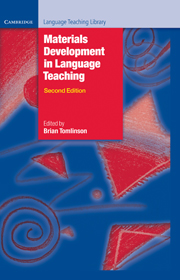Book contents
- Frontmatter
- Contents
- Preface
- Glossary of basic terms for materials development in language teaching
- Acknowledgements
- 1 Introduction: principles and procedures of materials development
- Part A Data collection and materials development
- 2 Using corpora in the language classroom
- 3 Concordances in the classroom without a computer: assembling and exploiting concordances of common words
- 4 Telling tails: grammar, the spoken language and materials development
- Comments on Part A
- Part B The process of materials writing
- 5 A framework for materials writing
- 6 Writing course materials for the world: a great compromise
- 7 How writers write: testimony from authors
- Comments on Part B
- Part C The process of materials evaluation
- 8 The analysis of language teaching materials: inside the Trojan Horse
- 9 Macro- and micro-evaluations of task-based teaching
- 10 What do teachers really want from coursebooks?
- 11 The process of evaluation: a publisher’s view
- Comments on Part C
- Part D The electronic delivery of materials
- 12 Developing language-learning materials with technology
- 13 New technologies to support language learning
- Comments on Part D
- Part E Ideas for materials development
- 14 Seeing what they mean: helping L2 readers to visualise
- 15 Squaring the circle – reconciling materials as constraint with materials as empowerment
- 16 Lozanov and the teaching text
- 17 Access-self materials
- Comments on Part E
- Conclusions
- Recommended reading
- Index
1 - Introduction: principles and procedures of materials development
Published online by Cambridge University Press: 09 February 2023
- Frontmatter
- Contents
- Preface
- Glossary of basic terms for materials development in language teaching
- Acknowledgements
- 1 Introduction: principles and procedures of materials development
- Part A Data collection and materials development
- 2 Using corpora in the language classroom
- 3 Concordances in the classroom without a computer: assembling and exploiting concordances of common words
- 4 Telling tails: grammar, the spoken language and materials development
- Comments on Part A
- Part B The process of materials writing
- 5 A framework for materials writing
- 6 Writing course materials for the world: a great compromise
- 7 How writers write: testimony from authors
- Comments on Part B
- Part C The process of materials evaluation
- 8 The analysis of language teaching materials: inside the Trojan Horse
- 9 Macro- and micro-evaluations of task-based teaching
- 10 What do teachers really want from coursebooks?
- 11 The process of evaluation: a publisher’s view
- Comments on Part C
- Part D The electronic delivery of materials
- 12 Developing language-learning materials with technology
- 13 New technologies to support language learning
- Comments on Part D
- Part E Ideas for materials development
- 14 Seeing what they mean: helping L2 readers to visualise
- 15 Squaring the circle – reconciling materials as constraint with materials as empowerment
- 16 Lozanov and the teaching text
- 17 Access-self materials
- Comments on Part E
- Conclusions
- Recommended reading
- Index
Summary
Introduction
This book concerns itself with what we could do in order to improve the quality of materials which are used for the teaching and learning of second languages. I would like to start the book by considering some of the steps which I think we could take and at the same time introducing issues which are dealt with in the various chapters of the book. I should stress that although the contributors to this book are basically likeminded in their approach to the development of L2 materials, many of the issues raised are controversial and some of the stances taken in the book are inevitably contradictory. In such cases we hope you will be informed, stimulated and able to make up your own mind by relating the authors’ stances to your own experience.
I am going to argue that what those of us involved in materials development should do is to:
1. Clarify the terms and concepts commonly used in discussing materials development.
2. Carry out systematic evaluations of materials currently in use in order to find out to what degree, how and why they facilitate language learning.
3. Consider the potential applications for materials development of current research into second language acquisition and into language use.
4. Consider the potential applications of what both teachers and learners believe is valuable in the teaching and learning of a second or foreign language.
5. Pool our resources and bring together researchers, writers, teachers, learners and publishers in joint endeavours to develop quality materials.
Terms and concepts
Let me start by clarifying some of the basic terms and concepts which you will frequently encounter in this book.
Materials
Most people associate the term ‘language-learning materials’ with coursebooks because that has been their main experience of using mater ials. However, in this book the term is used to refer to anything which is used by teachers or learners to facilitate the learning of a language. Materials could obviously be videos, DVDs, emails, YouTube, dictionaries, grammar books, readers, workbooks or photocopied exercises. They could also be newspapers, food packages, photographs, live talks by invited native speakers, instructions given by a teacher, tasks written on cards or discussions between learners.
- Type
- Chapter
- Information
- Materials Development in Language Teaching , pp. 1 - 32Publisher: Cambridge University PressPrint publication year: 2011
- 22
- Cited by

